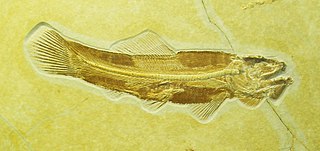
The Amiidae are a family of basal ray-finned fishes. The bowfin and the eyespot bowfin are the only two species to survive today, although additional species in all four subfamilies of Amiidae are known from Jurassic, Cretaceous, and Eocene fossils.

The Nymphalidae are the largest family of butterflies, with more than 6,000 species distributed throughout most of the world. Belonging to the superfamily Papilionoidea, they are usually medium-sized to large butterflies. Most species have a reduced pair of forelegs and many hold their colourful wings flat when resting. They are also called brush-footed butterflies or four-footed butterflies, because they are known to stand on only four legs while the other two are curled up; in some species, these forelegs have a brush-like set of hairs, which gives this family its other common name. Many species are brightly coloured and include popular species such as the emperors, monarch butterfly, admirals, tortoiseshells, and fritillaries. However, the under wings are, in contrast, often dull and in some species look remarkably like dead leaves, or are much paler, producing a cryptic effect that helps the butterflies blend into their surroundings.

The superfamily Papilionoidea contains all the butterflies except for the moth-like Hedyloidea.

Oecophoridae is a family of small moths in the superfamily Gelechioidea. The phylogeny and systematics of gelechoid moths are still not fully resolved, and the circumscription of the Oecophoridae is strongly affected by this.

The Heliconiinae, commonly called heliconians or longwings, are a subfamily of the brush-footed butterflies. They can be divided into 45–50 genera and were sometimes treated as a separate family Heliconiidae within the Papilionoidea. The colouration is predominantly reddish and black, and though of varying wing shape, the forewings are always elongated tipwards, hence the common name.

The Satyrinae, the satyrines or satyrids, commonly known as the browns, are a subfamily of the Nymphalidae. They were formerly considered a distinct family, Satyridae. This group contains nearly half of the known diversity of brush-footed butterflies. The true number of the Satyrinae species is estimated to exceed 2,400.
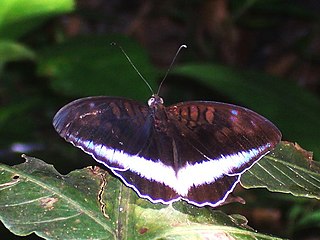
The Limenitidinae are a subfamily of butterflies that includes the admirals and relatives. The common names of many species and genera reference military ranks or – namely the Adoliadini – titles of nobility, in reference to these butterflies' large size, bold patterns, and dashing flight. In particular, the light stripe running lengthwise across the wings of many Limenitidini has reminded earlier authors of officers' shoulder marks and epaulets.

The Catocalinae are a subfamily of noctuoid moths, placed in family Noctuidae. In the alternative arrangement, where the Noctuidae are reduced to the core group around the Noctuinae, the present lineage is abolished, the upranked Catocalini being merged with the Erebini and becoming a subfamily of the reestablished family Erebidae.

Anartia is a genus of butterflies in family Nymphalidae, and subfamily Nymphalinae, found in tropical and subtropical areas in the Americas. The butterflies are known as peacocks, although the common European peacock is not in the same genus.
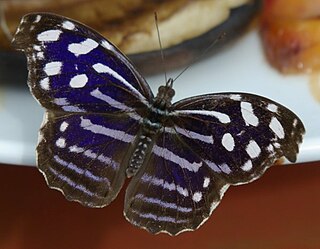
Biblidinae is a subfamily of nymphalid butterflies that includes the tropical brushfoots. This subfamily was sometimes merged within the Limenitidinae, but they are now recognized as quite distinct lineages. In older literature, this subfamily is sometimes called Eurytelinae.

Melitaea is a genus of brush-footed butterflies. They are here placed in the tribe Melitaeini of subfamily Nymphalinae; some authors elevate this tribe to subfamily rank.

Melitaeini are a group of brush-footed butterflies. Usually classified as a tribe of the Nymphalinae, they are sometimes raised to subfamily status as Melitaeinae. Common names include the highly ambiguous fritillaries, checkerspots, crescents, or crescentspots, and some genus-specific names.

Junonia evarete, the tropical buckeye or South American tropical buckeye, is a South American butterfly of the nymphalid (Nymphalidae) family. It has characteristic eye spots on the wings, which have a wingspan between 4.5 and 6.5 cm. This butterfly is easily confused with Junonia genoveva, the mangrove buckeye. Not only have the common names mangrove and tropical buckeye been confused, but the butterflies themselves have been sometimes misidentified in past literature because the two species have many variations, subspecies and seasonal forms, which makes them difficult to identify or differentiate. Phylogenetic studies demonstrate the separation of evarete and genoveva, but evidence suggests that subspecies and perhaps more species await their descriptions within this group.

Phengaris is a genus of gossamer-winged butterflies in the subfamily Polyommatinae. Commonly, these butterflies are called large blues, which if referring to a particular species is P. arion, a species resident in Europe and some parts of Asia.

Dichorragia nesimachus, the constable, is a species of nymphalid butterfly found in Asia. The genus was earlier considered to belong to the subfamily Cyrestinae and sometimes the Apaturinae, but is now considered as a sister of the genus Stibochiona in the subfamily Pseudergolinae. Several geographical forms with variations in colour are noted within the wide distribution range extending from India in the west to Japan in the east. In Vietnam, it is thought to show hill topping behaviour and is typically found in dense forest habitats. They may also be found mud puddling with other species.
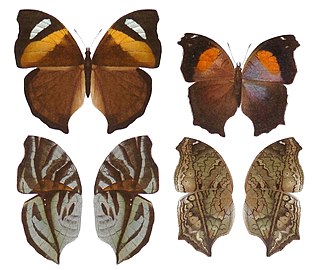
Salamis is a genus of nymphalid butterflies. They are commonly known as mother-of-pearls and are found in Africa. Salamis was a nymph in Greek mythology, the daughter of the river god Asopus and Metope, daughter of the Ladon, another river god.

Chlosyne leanira, the leanira checkerspot, is a butterfly of the family Nymphalidae. It is found in North America from western Oregon south to California, Nevada, Utah and western Colorado, as well as Baja California. The wingspan is 33–40 mm. Generally, females are larger than males, but males have a more apparent red color to their wings.
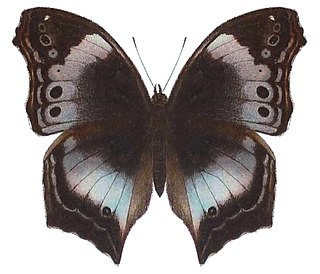
Protogoniomorpha cytora, the western blue beauty, is a butterfly in the family Nymphalidae. It is found in Guinea, Sierra Leone, Liberia, Ivory Coast, Ghana, Togo, and Benin. The habitat consists of open spaces in primary forests and mature secondary forests.

Kallimoides is a monotypic genus of butterflies in the family Nymphalidae. It contains only one species, Kallimoides rumia, the African leaf butterfly. It is found in Guinea, Sierra Leone, Liberia, Ivory Coast, Ghana, Nigeria, Bioko, Cameroon, Gabon, the Republic of the Congo, Angola, the Central African Republic, the Democratic Republic of the Congo, Uganda, Rwanda, Burundi and Tanzania. The habitat consists of forests.
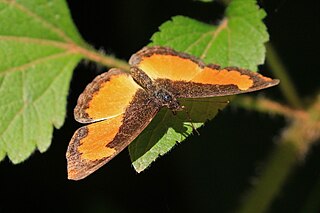
Vanessula is a monotypic butterfly genus in the family Nymphalidae. It contains only one species, Vanessula milca, the black and orange or lady's maid. It is found in Guinea, Sierra Leone, Liberia, Ivory Coast, Ghana, Nigeria, Cameroon, Gabon, the Republic of the Congo, Angola, the Democratic Republic of the Congo, Uganda, Kenya, Tanzania and Zambia. The habitat consists of dense and riverine forests.



















